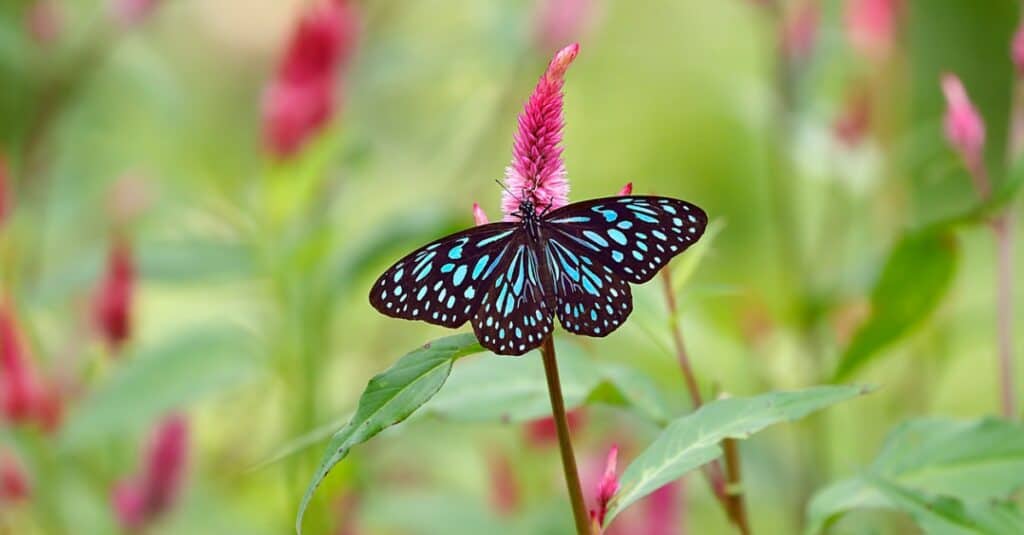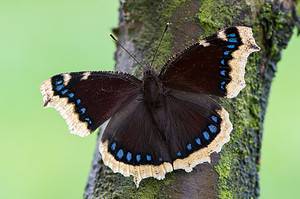Swathed in bright and beautiful colors, butterflies are among the most diverse animals on the planet. Sharing the same insect order, Lepidoptera, with moths, they seem to appear almost everywhere. Altogether, there are almost 20,000 documented species in the wild. Some of the most spectacular and colorful reside deep in the rainforest, but they come in so many different variations that each species seems to be adapted for the environmental conditions in which it evolved. This article will cover some fascinating details about where butterflies live and how they make their home in the wild.
Where in the World Are Butterflies Found?
The short answer to the question is that butterflies live on every single continent around the world except for Antarctica. They are very diverse and well-adapted for local conditions, but their distribution is not evenly spread. Since butterflies depend on warm climates to survive, the vast majority of them are found in Central and South America, Africa, southern Asia, and Australia. Some species are specialized to survive in temperate and cold climates as well; during the summer, they can be found almost as far north as the Arctic. The rise of globalization and fast travel has benefited some species (while hurting others). The monarch butterfly, once found exclusively in the Americas, has also spread to parts of Spain, Australia, New Zealand, and the rest of the Asian Pacific.
Which Habitats Do Butterflies Prefer?

©iStock.com/chris2766
Butterflies have adapted to survive in just about any habitat and ecological niche imaginable except for the most extreme cold. They usually prefer warm, open glades or woods with just enough vegetation to provide a home and source of food; many can be found in the rainforests and temperate forests as well. Other potential locations include inhospitable deserts, swampy wetlands, long coasts, and even huge mountaintops more than 20,000 feet tall. Unless migrating, butterflies usually don’t travel very far from the place of their birth.
Where Do Butterflies Live in the Winter?
The answer to that question depends on the species. Since butterfly physiology (as mentioned previously) is heavily dependent on external sources of heat for their survival, the butterfly species living closer to the equator and in the rainforest will tend to remain in the same place for much of the year. These warm climate species do have ways to cope with the changing wet and dry seasons, but they don’t migrate long distances and mostly remain active at nearly all times of the year.
Butterflies have more difficulty surviving in cold or temperate areas where the temperature drops below freezing for at least part of the time in the winter. When this occurs, they have two options to survive: either they enter a state of prolonged dormancy (not quite the same thing as hibernation), or they travel toward warmer climates to wait out the cold. The first strategy is known as overwintering. Butterflies can overwinter at any stage of their lives: eggs, larva, pupa, or adult. The larval stage is the most common time for overwintering, simply because butterflies spend so much time in this stage. The pupa is a common overwintering stage as well because they can remain dormant and protected inside of the silk cocoon, but it’s much less common for them to overwinter in the egg stage or the adult stage. Some species can overwinter for multiple stages of their lives, usually combining the larva and pupa stages together into a single season.
As the daylight begins to shorten in the winter, these butterflies will find a safe tree hole, manmade structure, or other crevices in which they can easily survive the freezing temperature of the surrounding environment. Then they will dramatically reduce their activity level to avoid expending unnecessary energy, living off the fat reserves they acquired from the summer and autumn. This is akin to a state of long sleep (though it doesn’t technically meet the definition of hibernation).
Migration is a much less common strategy than overwintering because many adults die before the winter even begins. The process itself also presents enormous difficulties and dangers for a butterfly, and so species must be highly adapted to make the journey. The first challenge is successful navigation. They must know instinctively where to travel even when they’ve never made the journey before. Butterflies appear to use the position of the sun, checked against the internal rhythm of their body clock (so they know the time of day), to find the correct direction. In order to locate the sun, they seem to rely on ultraviolet and polarized light, well beyond the capabilities of normal human vision, to navigate long routes and orient themselves even in cloudy conditions.
The monarch butterfly is perhaps the most well-known of all the migratory species – and also one of the few to make regular annual migrations like birds. They seem to travel instinctively south thousands of miles toward California and Mexico, roosting along the way at night in pine, cedar, and fir trees. When roosting, they congregate close together, sometimes numbering in the millions. Then they make the opposite journey in the springtime toward their normal breeding grounds.
For sheer migratory length, however, nothing can beat the painted lady butterfly, which undertakes a long migration between Africa and Europe at period points in time (migration does not occur every year and may be linked in some way to changing environmental conditions). One type of British painted lady makes a 9,000-mile trip, the longest on record. This migration takes so long that multiple generations will live and die before it’s completed.
Which Plants Do Butterflies Prefer?

©iStock.com/Dmitrii Melgunov (Ritam)
The answer to that question depends on the life stage of the butterfly in the wild. Caterpillars are specialized to spend the first few months or years of their lives on a specific host plant, feeding during the day and sleeping at night until they’re old enough to transform into adults. For instance, the larva of the monarch butterfly prefers to make any one of the milkweeds plants its host, including the California milkweed, the Arizona milkweed, the common milkweed, and many other species. Since milkweed is so common, there’s almost no shortage of food for the monarch larva to eat. The European peacock butterfly, on the other hand, will seek out the stinging nettle, small nettle, or hop plant to lay its eggs on.
Some species are so highly specialized that they cannot live anywhere else except for their host plant. The Karner blue butterfly, for instance, is completely dependent on oak savannas for survival. This species has been rendered extinct in parts of Canada where this habitat has completely disappeared. Other species will spend part of their lives as larvae in underground burrows or somewhere near the ground. Some of these butterflies have a unique symbiotic relationship in which ants help them survive and in exchange, the butterflies provide the ants with sweet honeydew.
When the caterpillar has fully grown, it will transform into a pupa by encasing itself in a silk cocoon. These pupas are usually found suspended from a branch, hidden under a leaf, or burrowed underground close to the site of its birth. Once it has emerged from its cocoon, the adult will be fully capable of flight, which opens up a much broader scope of travel.
At this point in its life, the butterfly is highly specialized for feeding on certain flower parts such as nectar or pollen with its long, coiled proboscis (although some adults that live for a very short span of time won’t feed at all before reproducing and dying). The wings help make them highly mobile in order to travel from flower to flower in search of food. They tend to do most of their feeding during the day and then sleep at night by hanging upside down from leaves and twigs, hidden among the foliage. Migratory species tend to have the greatest range of food sources in order to feed along the entire migration route.
Symbolic Meanings of Butterflies
While it is thrilling to behold a beautiful butterfly flying from flower to flower – for many it’s sighting has a deeper meaning. Butterflies represent the souls of the departed in many cultures from present day to the distant past. In ancient Greek the word for butterfly is “psyche” which means “soul”, and also appeared on Roman coins as a symbol of the soul. The Aztecs believed that the happy dead in the form of butterflies would visit their relatives to assure them that all was well. Mexico, Russia, Ireland, Spain and Germany all have lore associating butterflies with souls. In images of the Garden of Eden, Adam’s soul is symbolized by a butterfly, or drawn with butterfly wings.
Up Next…
- Butterfly Weed vs Milkweed: What’s the Difference?: Planning a butterfly garden? Read this to learn which plants attract these lovely creatures.
- How to Draw a Butterfly in 8 Easy Steps: Butterflies symbolize the soul and are a favorite subject of artists. Learn to draw a beautiful butterfly yourself with this easy guide!
- What Do Swallowtail Caterpillars Eat?: There are nearly 500 species of Swallowtail. Find our what they eat to attract them to your garden!
- Butterfly Poop: Everything You’ve Ever Wanted to Know: Everybody poops – even these little beauties! Their poop may be more interesting than you think!
The photo featured at the top of this post is © iStock.com/McKinneMike
Thank you for reading! Have some feedback for us? Contact the AZ Animals editorial team.






